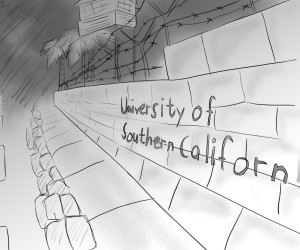DPS’ presence still lacking west of campus
Last Tuesday, two men were killed and one injured in series of gang-related shootings to the west of campus. The final shooting was also the closest, taking place near the intersection of Catalina and 36th streets, a block from the Vermont Avenue entrances to the university.
The distance between the scene of this third shooting and the perimeter of campus was roughly equivalent to the space between McCarthy Quad and the Pertusati Bookstore. Walking at a leisurely pace, it would take most students less than five minutes to cover that area.
To say the shootings were close to home would be an understatement. They took place right on the school’s front porch.
Though no USC students were harmed in the day’s ordeals, it’s just as unnerving to know that there were three shootings that occurred less than a half a mile from the enclave of the university.
Following the incidents, LAPD investigations concluded that the shootings were most likely gang-related homicides, with each of the victims a premeditated target.
In recent years, the USC community has made a concerted effort to reach out to help address problems related to gang violence. The School of Social Work offers a course, titled Adolescent Gang Intervention (SOWK 350), in which students collaborate with city officials to work on gang prevention and intervention strategies. In addition, former football coach Pete Carroll’s “A Better LA” organization has worked to try to curb the alarming pattern of gang violence in the area.
But while the successes of such efforts have been well documented, there have still been sobering reminders of the status quo.
In October 2008, alleged gang members shot USC track team member Bryshon Nellum just northwest of campus. There is still no clear motive for the crime.
Last week’s shootings serve as the latest reminder.
Unfortunately, the shootings will do little to dispel the belief that the area surrounding USC is a hotbed of rampant crime and dangerous activity. Rather than resorting to the de facto apoplectic rant that paints the school’s safety efforts as ineffectual, we should acknowledge the fact that while such events are unfortunate, the work of the university and local law enforcement has curbed them.
Already, DPS has pledged to increase its presence in the area through a “variety of DPS resources” where the shootings took place in an effort to curb any further violent acts. But this move is reactionary in nature, especially considering the fact that the plan was to redeploy resources that had been utilized in the area once before.
To build upon this relative success, DPS should move to expand its proactive measures in order to better safeguard the area around campus, much in the same way that it encourages students to take prior precautions to ensure personal safety. If nothing else, this could establish a presence that will preempt possible violent acts.
For instance, while the distribution of DPS personnel currently seems to be based on the largest concentrations of students around campus — especially to the north — it would be greatly beneficial to have a stronger presence in areas of the off-campus perimeter particularly susceptible to crime, regardless of the spotty student population.
Taking such precautions, would serve as a great step toward DPS’ stated goal to “create a safe and secure community.”
Soojin Yoon is a senior majoring in public relations.

